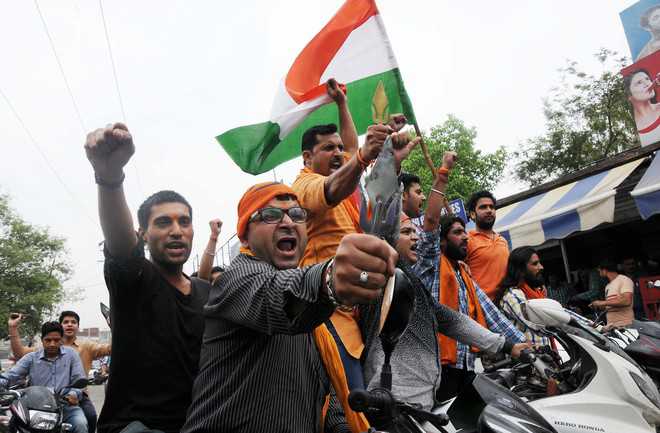
Age of jingoism: The author has explored the four visions of nationalism prevalent in India, all of which have engaged in a battle for hegemony over the cultural cast of the nationTribune photo
Rumina Sethi
“Imaginings”, “pan-Indian”, and “nationhood” are among some of the significant terms that first catch one’s attention on reading Vikas Pathak’s book, Contesting Nationalisms. Nationalism itself is a contested terrain, seeking homogeneity through the constant summoning of imagination, pan-ness and nationhood.
Nationalism bears the cross of unifying diverse strains. A coming-of-age nation-state is cleft with a diversity of aspects. It has to deal with class difference, caste barriers, gender discrimination, religious pluralism, and even sexual orientation. How can a nation-state proclaim sovereignty on political territorialism alone, without consolidating the multiplicity of voices? Such a conundrum invokes the aid of imagination that allows the many communities, groups, cults, regions and sects to display a one-ness or a “pan” culture. Here is where a common past, a common tradition, and a common culture come into play. We end up believing that we have a common family owing to the “cultural” representation of nationalism: martyrs and heroes, landscape, epics, songs and anthems, festivals, museums of folklore, gods and sages, are summoned to appeal at a cultural level to bring a greater acceptance than an emphasis on a unificatory religion, which tends to get resisted. This is where imagination plays a part.
Urban nationalist intellectuals have the knack of making speeches and writing tracts, which can be so powerful and potent, as well as effective, that the nation assumes a concrete presence. Of course, it is not cultural impact alone that underscores this unification. A nation’s constitution, its idea of citizenship, rights and duties, armies, currency, and much more, serve to make sure we imbibe the concept of unity and integrity. History gives evidence that such cultural unifications created one’s sense of pan-Arabism, pan-Indianness, pan-Islamism and Negritude. But such efforts are fraught with friction and factionalism, which makes the task of national unification or the creation of national consciousness among its citizenry a very difficult undertaking indeed. In anti-colonial national formation, as in India, even after the successful achievement of revolution, the volatile beast of ‘diversity’ continually rears its head reminding us that all is not well with the polity.
It is with these undercurrents in mind that Pathak explores the terrain of four visions of nationalism prevalent in India, all of which “were engaged in a battle for hegemony over the cultural cast of the Indian nation.” These four strains can be identified as the “composite”, that sought to bring harmony among the various national identities; the “secular”, that broke with the community to inculcate a united citizenship; the “religious”, that emphasised a core ethnic culture; and that of the “Depressed” classes, which was based on a unity between Dalits, who considered themselves completely disenfranchised. Within this spectrum, Pathak scrutinises secularists like Jawaharlal Nehru and Bhagat Singh, seekers of the religious Hindu nation such as Savarkar and Bhai Parmanand, viewers of a composite nation like Madan Mohan Malaviya and Lala Lajpat Rai, and those who articulated the perspective of the Depressed classes like Ambedkar and Mangoo Ram. He emphasises how none of these views compartmentalised ideology to suit their temperament but accentuated flux. Yet, the element of appropriation cannot be dismissed.
Pathak’s particular focus is colonial Punjab in the late 19th and early 20th centuries, within which he proposes alternatives to the dominant “secular” and “composite” brands of nationalism, and argues for the preponderance of a religious nationalist vision as well as that of the Depressed Classes. For them, colonialism was not the enemy since both conceive of an internal antagonist “other”: the former sees the Muslims as opponents whereas the latter is threatened by the upper-caste Brahmins.
What draws one to Pathak’s research is his stated proclivity for disagreement and discussion, without forcing a resolution from a “prescriptively moralist position”. Yet, in certain places, his intention to forge a sentiment enshrining the ‘Hindu Rashtra’ with an ‘Indian’ nationalism can be glimpsed. This would not include within itself the secularism represented by the Congress or the composite culture believed to embrace all difference. Can this ‘Hindu Rashtra’ version be non-secessionist, the author seeks to ask.
What goes to Pathak’s credit is his substantial effort in bringing together the individual essence of the many strains of nationalism in India while giving evidence of the repeated overlap, strategic or otherwise, in the attempt to hegemonise itself as pan-Indian and make it consistent with what is known as Indian nationalism.



























